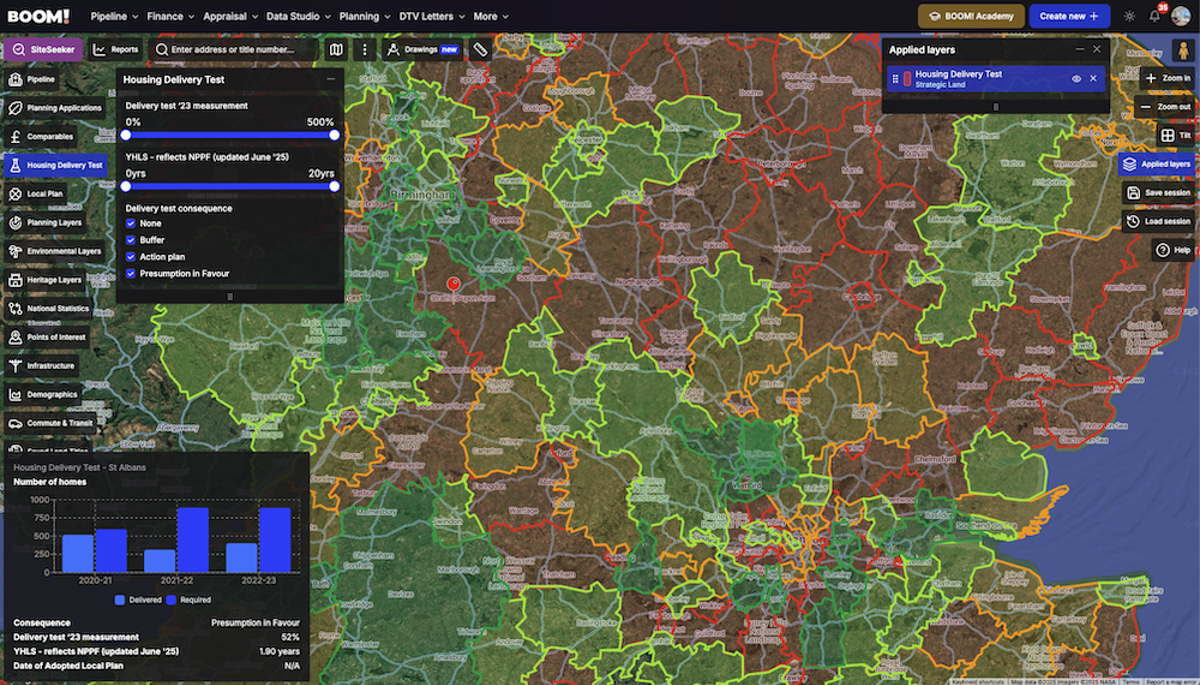How a “Boring” Housing Land Supply Rule Can Fast-Track Your Next Development







Wondering how to find land for development in the UK that actually gets planning permission? What if one little-known planning metric could tilt the odds in your favour? Many new developers struggle with the planning permission UK process, jumping through hoops only to hit rejection. But a quiet crisis in council housing targets might be your golden opportunity. Enter the concept of “five-year housing land supply” – a wonky-sounding rule that, if played right, can help you secure sites and approvals that others overlook. And with nearly half of English councils failing to meet this requirement , the time to act is now.
What Is a 5-Year Housing Land Supply (and Why Should You Care)?
Every local planning authority in England is expected to identify “deliverable” housing sites for the next five years of projected demand. Think of it as the council’s housing pipeline – a plan to meet the area’s housing need for the immediate future. This five-year supply isn’t just a goal; it’s a national policy requirement. Councils usually publish an annual 5-year land supply report or include it in their monitoring updates. For example, Pendle Borough Council’s latest assessment shows they only have 2.79 years’ worth of housing land identified – well under the five-year mark. They’re not alone. Official data shows nearly half of local councils in England cannot currently demonstrate a full five-year housing land supply.
Why does this matter to you as a developer or land sourcer? Because when a council falls short, planning rules shift in your favour. Under the National Planning Policy Framework (NPPF), if a council can’t prove a five-year supply, its housing policies are considered out-of-date and the “presumption in favour of sustainable development” automatically applies. In plain English: the default answer to a new housing proposal becomes “yes” unless there’s a very strong reason to refuse.
The result? Developers can get permission on sites that might otherwise be outside of the local plan or even on protected land.
It’s worth noting that the five-year land supply rule comes with a few technical nuances. Councils must include a buffer (usually 5% extra, or 20% if they’ve been missing targets badly) to ensure a cushion of deliverable sites. They base the target either on their adopted housing requirement or (if the local plan is outdated) on a government-calculated standard method figure for housing need. All this boils down to one thing: councils are under pressure to keep that five-year pipeline filled. And if they can’t? That pressure transfers to relief – and opportunity – for developers like you.
Leverage the Shortfall: How to Use 5-Year Land Supply to Find Sites

Knowing about the five-year land supply is empowering, but how do you put it into action? Here’s a step-by-step game plan:
Target the Right Areas: Start your site sourcing by identifying which councils are running short on housing land supply, you can find this info within BOOM!. Industry news sources and tools also compile these figures – as of 2025, roughly half of England’s planning authorities are below the five-year mark. Focus on these areas first when hunting for development land.
Do Your Homework: Once you’ve picked a council area with a shortfall, dig a little deeper. What number of years’ supply are they claiming – 4 years? 3 years? Less? The lower the number, the stronger your position. Also check if the council has recently lost appeals due to housing shortfall (a quick search of planning appeals in the area can reveal this). This gives you proof to bolster your case. Gather some local stats: housing requirement vs. identified supply, recent delivery rates, etc. Having those facts shows you’ve done your due diligence.
Find Promising Sites: Look for land that wasn’t allocated in the local plan or was previously dismissed as “too outside settlement” or in light constraints. In a normal scenario, those sites might be long shots. But in a council with, say, only 3 years of supply, that infill plot on the edge of the village or that piece of greenfield by the bypass suddenly has a much better chance. How to find land for development in the UK with this edge? Use BOOM! to spot unused lands in those target councils, then verify ownership and any planning history. Many successful small developers zero in on under-supplied districts and quickly secure options on land others ignored.
Align Your Planning Strategy: When submitting your planning application, lean into the housing shortfall angle. In your Planning, Design and Access Statement (or covering letter), explicitly mention the council’s inability to demonstrate a five-year supply. Explain how your proposed development will help bridge the gap. This isn’t an emotional plea – it’s planning policy gold. By showing that approval of your project would contribute to the council’s housing needs, you’re pressing on a pressure point in policy. Decision-makers know that with no 5-year supply, the presumption is to approve. You’re basically reminding them of that obligation.
Be Ready to Appeal (if needed): Even with a shortfall, some councils might still refuse projects – old habits die hard. Don’t be discouraged. The appeal route is where the “tilted balance” really comes into play. Planning inspectors are well aware of the rules and often overturn refusals in under-supplied areas, as seen in numerous cases from Essex to Lancashire. Make sure you highlight the housing land supply shortage in your appeal grounds. The key phrase to use is that the local plan policies are “out of date due to a lack of a five-year housing land supply”, invoking NPPF paragraph 11 and the presumption in favour of development. This is often the trump card that wins appeals when all else is balanced.
Stay Alert to Policy Changes: Finally, keep your ear to the ground. The planning system isn’t static. There have been talks of tweaking or even scrapping the 5-year land supply rule for councils with up-to-date plans (as proposed in the Levelling Up and Regeneration Bill). And with upcoming elections and new housing targets, rules might change. But as of 2025, the requirement is very much in force – meaning right now is a prime window to use it. If reforms come, we’ll adapt. Until then, this is a loophole you don’t want to leave on the table.
Turn Shortfall into Opportunity
In the high-stakes world of UK property development, knowledge truly is power. The years of housing land supply metric might not make flashy headlines, but it’s a game-changer for those in the know. Instead of feeling at the mercy of the planning system, you can flip the script: target the councils that need you. It injects urgency and specificity into your search – you’re not just looking for any site, you’re looking for the right site in the right location where the council is under pressure to say yes.
By incorporating five-year land supply research into your workflow, you’ll approach site sourcing with a sharper eye and a strategic edge. You’re no longer guessing where development might be welcome – you have a data-backed signal from the councils themselves. This direct, targeted approach can save you time, reduce wasted planning fees, and increase your success rate in securing planning permission. It’s about working smarter, seizing the moment of opportunity that exists when a local authority is hungry to meet housing numbers.
The housing shortage in England isn’t going away overnight, and small developers have a pivotal role in filling the gap. So use this insight. Empower yourself with the same data councils scramble to improve. Next time you read that a council only has 3 or 4 years of housing land supply, see it as a green light to explore development there. The door is open – walk through it with confidence, armed with proof, and make your project the solution they’ve been looking for. After all, in a system weighed down by red tape, it’s thrilling to find a shortcut that not only benefits you, but also helps deliver the homes communities need. Now that you know about the 5-year land supply rule, go out and put this knowledge to work – your next planning win might be much closer than you think.
Get started now with Housing Land Supply now or book a call with us to show you how we can help.